The Lower Pleistocene Tephra Layers in the Crotone Marine Sequence of Southern Italy: Tracing Their Volcanic Source Area
Abstract
:1. Introduction
2. Geological Setting
2.1. The Crotone Basin
2.2. The Crotone Series
2.3. The Tephra Layers
3. Materials and Methods
3.1. Sampling
3.2. Analytical Methods
4. Results
4.1. Petrography
4.2. Mineral Chemistry
4.3. Glass Chemistry
5. Discussion
5.1. Single vs. Multiple Volcanic Sources
5.2. Correlation with Other Pleistocene Tephras in the Mediterranean Area

5.3. Source Area(s)
6. Conclusions
- 1-
- At least three tephra layers are interbedded in the Lower Pleistocene sequence of the Crotone basin. Though no specific sedimentological analysis was possible, due to the cohesion of the tephras, the lack of visible traction structures, the rather homogeneous grain size of each layer and the absence of non-volcanic components point to a primary origin of these tephras, deriving from the ash transported by the wind in the umbrella region of a Plinian column(s), deposited and poorly reworked in a deep marine environment. The occurrence in the mineralogical assemblage of the three tephras of ortho- and clinopyroxene, together with the composition of the trace elements of the glass shards, allows us to infer that they are related to subduction-related volcanism. According to the prevalent dispersion towards the east of the eruptive columns in the Mediterranean area, the source could be identified in a paleo-arc located in the Central Tyrrhenian Sea, possibly identifiable with the Ventotene volcanic ridge.
- 2-
- The lowermost layer (a1, 2.31 ± 0.34 Ma) is made up of compositionally highly homogeneous rhyolitic glass shards and crystals of plagioclase, ortho- and clinopyroxene and amphibole. The age, petrography and composition of the glass allow us to correlate this layer to the tephra layers that crop out in Basilicata and central Italy. It therefore represents evidence of a highly explosive activity occurring in the paleo-arc during the Lower Pleistocene, whose products were dispersed over a wide area.
- 3-
- Due to its uncertain position and its high weathering degree, no correlation was possible for sample A1, possibly representative of layer a2 of [12]. The mineralogical assemblage is given by plagioclase, orthopyroxene, amphibole, biotite and subordinate clinopyroxene. The few analyzed glass shards have a rhyolitic composition and a lower alkali content with respect to the other layers.
- 4-
- The age of the a3 layer is unknown, but, due to its stratigraphic position, it must be comprised between that of a1 and 1.8 Ma (i.e., the age of the Gelasian–Calabrian limit). Its mineralogical assemblage is represented by plagioclase, ortho- and clinopyroxene and rare oxides. The composition of the glass shards is rhyolitic, and at least two populations of glass shards have been identified. No correlation with known tephra layers in the Mediterranean area was possible for this layer.
- 5-
- Layer a4 lies above the Gelasian–Calabrian limit, which allows us to infer an age younger than 1.8 Ma. The mineralogical assemblage is given by plagioclase, biotite, ortho- and clinopyroxene; apatite and Fe-Ti oxides are accessory phases. Most of the glass shards and pumices of which it is composed are aphiric and highly vesiculated, with a silica content of about 69 wt.%. The occurrence of a second population of highly crystalline, less vesiculated, and less silica-rich glass shards could indicate the contribution of multiple sources or an origin related to a chemically heterogeneous magma. Also, for this layer, no possible correlation was found.
- 6-
- The detailed petrographic and geochemical characterization of the tephra layers interbedded in the Crotone marine sequence, besides adding further knowledge to the best-studied early Pleistocene succession in the world, is of great importance for future identification and correlation of Gelasian–Calabrian sequences in the Mediterranean area. In the Crotone sequence, the GSSP of the base of the Calabrian stage occurs between two of the studied tephra layers, namely a3 and a4. As they are easily recognizable in the field, while the sapropel “e” is not always easily identified [9], their finding and identification are of great importance in stratigraphic studies as intra-basinal marker beds. In this work, we could not recognize these two tephras in other sedimentary basins. However, future studies could reveal their occurrence in other lower Pleistocene sequences, such as those in which the lowermost a1 layer has been recognized. The correlation on a petrographic and compositional basis with those of Vrica will be fundamental for stratigraphic correlations of Lower Pleistocene sequences at a regional scale.
Supplementary Materials
Author Contributions
Funding
Data Availability Statement
Acknowledgments
Conflicts of Interest
References
- Giaccio, B.; Nomade, S.; Wulf, S.; Isaia, R.; Sottili, G.; Cavuoto, G.; Galli, P.; Messina, P.; Sposato, A.; Sulpizio, R.; et al. The late MIS 5 Mediterranean tephra markers: A reappraisal from peninsular Italy terrestrial records. Quat. Sci. Rev. 2012, 56, 31–45. [Google Scholar] [CrossRef]
- Petrosino, P.; Jicha, B.R.; Mazzeo, F.C.; Ciaranfi, N.; Girone, A.; Maiorano, P.; Marino, M. The Montalbano Jonico marine succession: An archive for distal tephra layers at the EarlyeMiddle Pleistocene boundary in southern Italy. Quatern Int. 2015, 383, 89–103. [Google Scholar] [CrossRef]
- Donato, P.; Albert, P.G.; Crocitti, M.; De Rosa, R.; Menzies, M.A. Tephra layers along the southern Tyrrhenian coast of Italy: Links to the X-5 & X-6 using volcanic glass geochemistry. J. Volcanol. Geoth Res. 2016, 317, 30–41. [Google Scholar] [CrossRef]
- De Rosa, R.; Dominici, R.; Donato, P.; Barca, D. Widespread syn-eruptive volcaniclastic deposits in the Pleistocenic basins of South-western Calabria. J. Volcanol. Geoth Res. 2008, 177, 155–169. [Google Scholar] [CrossRef]
- Petrosino, P.; Russo Ermolli, E.; Donato, P.; Jicha, B.; Robustelli, G.; Sardella, R. Using tephrochronology and palynology to date the MIS 13 lacustrine sediments of the Mercure basin (Southern Apennines—Italy). Ital. J. Geosci. 2014, 133, 169–186. [Google Scholar] [CrossRef]
- Cannata, C.B.; De Rosa, R.; Donato, P.; Morrone, C.; Muto, F. High preservation potential volcaniclastic sedimentation in the Serravallian sequence of the Amantea basin (Coastal Chain, North-Western Calabria). Geosciences 2021, 11, 360. [Google Scholar] [CrossRef]
- Potere, D.; Iezzi, G.; Scisciani, V.; Tangari, A.; Nazzari, M. Provenance and deposition of a lithified volcanic-rich layer (VRL-5.5) at 5.5 Ma from Central Apennines (Italy). Sci. Rep. 2023, 13, 6880. [Google Scholar] [CrossRef] [PubMed]
- Roverato, M.; Farina, F.; Lupi, M.; Ovtcharova, M.; Montanari, A.; Bonini, M.; Montanari, D. Upper Miocene volcanic ash layers from central Italy: Tracking down the volcanic source. B Volcanol. 2024, 86. [Google Scholar] [CrossRef]
- Cita, M.B.; Gibbard, P.L.; Head, M.J. and the ICS Subcommission on Quaternary Stratigraphy. Formal ratification of the GSSP for the base of the Calabrian Stage (second stage of the Pleistocene Series, Quaternary System). Episodes 2012, 35, 388–397. [Google Scholar] [CrossRef]
- Hilgen, F.J. Closing the gap in the Plio-Pleistocene boundary stratotype sequence of Crotone (southern Italy). Newsl. Stratigr. 1990, 22, 43–51. [Google Scholar] [CrossRef]
- Lourens, L.J.; Hilgen, F.J.; Raffi, I.; Vergnaud-Grazzini, C. Early Pleistocene chronology of the Vrica section (Calabria, Italy). Paleoceanography 1996, 11, 797–812. [Google Scholar] [CrossRef]
- Suc, J.P.; Combourieu-Nebout, N.; Seret, G.; Popescu, S.M.; Klotz, S.; Gautier, F.; Clauzon, G.; Westgate, J.; Insinga, D.; Sandhu, A.S. The Crotone series: A synthesis and new data. Quatern Int. 2010, 219, 121–133. [Google Scholar] [CrossRef]
- Maiorano, P.; Capotondi, L.; Ciaranfi, N.; Girone, A.; Lirer, F.; Marino, M.; Pelosi, N.; Petrosino, P.; Piscitelli, A. Vrica-Crotone and Montalbano Jonico sections: A potential unit-stratotype of the Calabrian Stage. Episodes 2010, 33, 218–233. [Google Scholar] [CrossRef]
- Van Dijk, J.P. Basin dynamics and sequence stratigraphy in the Calabrian Arc (central Mediterranean); records and pathways of the Crotone Basin. Geol. Mijnbouw 1991, 70, 187–201. [Google Scholar]
- Van Dijk, J.P. Late Neogene kinematics of intra-arc oblique shear zones: The Petilia-Rizzuto Fault Zone (Calabrian Arc, central Mediterranean). Tectonics 1994, 13, 1201–1230. [Google Scholar] [CrossRef]
- Van Dijk, J.; Okkes, M. Neogene tectonostratigraphy and kinematics of Calabrian basins; implications for the geodynamics of the Central Mediterranean. Tectonophysics 1991, 196, 23–60. [Google Scholar] [CrossRef]
- Van Dijk, J.P.; Bello, M.; Brancaleoni, G.P.; Cantarella, G.; Costa, V.; Frixa, A.; Golfetto, F.; Merlini, S.; Riva, M.; Torricelli, S.; et al. A regional structural model for the northern sector of the Calabrian Arc (southern Italy). Tectonophysics 2000, 324, 267–320. [Google Scholar] [CrossRef]
- Civile, D.; Zecchin, M.; Tosi, L.; Da Lio, C.; Muto, F.; Sandron, D.; Affatato, A.; Accettella, D.; Mangano, G. The Petilia-Sosti Shear Zone (Calabrian Arc, southern Italy): An onshore-offshore regional active structure. Mar. Pet. Geol. 2022, 141, 105693. [Google Scholar] [CrossRef]
- Tansi, C.; Muto, F.; Critelli, S.; Iovine, G. Neogene-Quaternary strike-slip tectonics in the central Calabrian Arc (southern Italy). J. Geodyn. 2007, 43, 393–414. [Google Scholar] [CrossRef]
- Mangano, G.; Alves, T.M.; Zecchin, M.; Civile, D.; Critelli, S. The Rossano-San Nicola Fault Zone evolution impacts the burial and maturation histories of the Crotone Basin, Calabrian Arc, Italy. Petrol. Geosci. 2023, 29, petgeo2022-085. [Google Scholar] [CrossRef]
- Mangano, G.; Zecchin, M.; Civile, D.; Critelli, S. Tectonic evolution of the Crotone Basin (central Mediterranean): The important role of two strike-slip fault zones. Mar. Pet. Geol. 2024, 163, 106769. [Google Scholar] [CrossRef]
- Malinverno, A.; Ryan, W.B. Extension in the Tyrrhenian Sea and shortening in the Apennines as result of arc migration driven by sinking of the lithosphere. Tectonics 1986, 5, 227–245. [Google Scholar] [CrossRef]
- Sartori, R. The main results of ODP Leg 107 in the frame of Neogene to Recent geology of peri-Tyrrhenian areas. In Proceedings of the Ocean Drilling Program, Scientific Results; Kastens, K.A., Mascle, J., Auroux, C., Bonatti, E., Broglia, C., Channell, J., Curzi, P., Emeis, R.K., Glaçon, G., Hasegawa, S., et al., Eds.; Ocean Drilling Project: College Station, TX, USA, 1990; Volume 107, pp. 715–730. [Google Scholar]
- Patacca, E.; Sartori, R.; Scandone, P. Tyrrhenian basin and Apenninic arcs: Kinematic relations since late Tortonian times. Mem. Soc. Geol. Ital. 1990, 45, 425–451. [Google Scholar]
- Gueguen, E.; Doglioni, C.; Fernandez, M. On the post-25 Ma geodynamic evolution of the western Mediterranean. Tectonophysics 1998, 298, 259–269. [Google Scholar] [CrossRef]
- Bonardi, G.; Cavazza, W.; Perrone, V.; Rossi, S. Calabria-Peloritani terrane and northern Ionian sea. In Anatomy of an Orogen: The Apennines and Adjacent Mediterranean Basins; Vai, G., Marini, I.P., Eds.; Springer: Dordrecht, The Netherlands, 2001; pp. 287–306. [Google Scholar]
- Critelli, S.; Martín-Martín, M. Provenance, Paleogeographic and paleotectonic interpretations of Oligocene-Lower Miocene sandstones of the western-central Mediterranean region: A review, in the evolution of the Tethyan orogenic belt and, related mantle dynamics and ore deposits. J. Asian Earth Sci. 2022, X8, 100124. [Google Scholar] [CrossRef]
- Martín-Martín, M.; Perri, F.; Critelli, S. Cenozoic detrital suites from the Internal Betic-Rif Cordilleras (S Spain and N Morocco): Implications for paleogeography and paleotectonics. Earth Sci. Rev. 2023, 243, 104498. [Google Scholar] [CrossRef]
- Capraro, L.; Macrì, P.; Scarponi, D.; Rio, D. The lower to Middle Pleistocene Valle di Manche section (Calabria, Southern Italy): State of the art and current advances. Quatern Int. 2015, 383, 36–46. [Google Scholar] [CrossRef]
- Falsetta, E.; Bullejos, M.; Critelli, S.; Martín-Martín, M. 3D modeling of the stratigraphic and structural architecture of the Crotone basin (southern Italy) using machine learning with Python. Mar. Pet. Geol. 2024, 164, 106825. [Google Scholar] [CrossRef]
- Zecchin, M.; Caffau, M.; Civile, D.; Critelli, S.; Di Stefano, A.; Maniscalco, R.; Muto, F.; Sturiale, G.; Roda, C. The Plio-Pleistocene evolution of the Crotone Basin (southern Italy): Interplay between sedimentation, tectonics and eustasy in the frame of Calabrian Arc migration. Earth Sci. Rev. 2012, 115, 273–303. [Google Scholar] [CrossRef]
- Zecchin, M.; Praeg, D.; Ceramicola, S.; Muto, F. Onshore to offshore correlation of regional unconformities in the Plio-Pleistocene sedimentary successions of the Calabrian Arc (central Mediterranean). Earth Sci. Rev. 2015, 142, 60–78. [Google Scholar] [CrossRef]
- Gliozzi, E. I terrazzi del Pleistocene superiore della Penisola di Crotone (Calabria). Geol. Rom. 1987, 26, 17–79. [Google Scholar]
- Zecchin, M.; Nalin, R.; Roda, C. Raised Pleistocene marine terraces of the Crotone peninsula (Calabria, southern Italy): Facies analysis and organization of their deposits. Sediment. Geol. 2004, 172, 165–185. [Google Scholar] [CrossRef]
- Hilgen, F.J. Astronomical calibration of Gauss to Matuyama sapropels in the Mediterranean and implication for the geomagnetic Polarity Time Scale. Earth Planet. Sc. Lett. 1991, 104, 226–244. [Google Scholar] [CrossRef]
- Zijderveld, J.D.A.; Hilgen, F.J.; Langereis, C.G.; Verhallen, P.J.J.M.; Zachariasse, W.J. Integrated magnetostratigraphy and biostratigraphy of the upper Pliocene- lower Pleistocene from the Monte Singa and Crotone areas in Calabria, Italy. Earth Planet. Sc. Lett. 1991, 107, 697–714. [Google Scholar] [CrossRef]
- Aguirre, E.; Pasini, G. The Pliocene -Pleistocene Boundary. Episodes 1985, 8, 116–120. [Google Scholar] [CrossRef]
- Bassett, M.G. Towards a “Common Language” in Stratigraphy. Episodes 1985, 8, 87–92. [Google Scholar] [CrossRef]
- Pasini, G.; Colalongo, M.L. The Pliocene-Pleistocene boundary-stratotype at Vrica, Italy. In The Pleistocene Boundary and the Beginning of the Quaternary; Van Couvering, J.A., Ed.; Cambridge University Press: Cambridge, UK, 1997; pp. 15–45. [Google Scholar]
- Lourens, L.J.; Hilgen, F.J.; Raffi, I. Base of Large Gephyrocapsa and astronomical calibration of Early Pleistocene sapropels in Site 967 and Hole 969D: Solving the chronology of the Vrica section (Calabria, Italy). In Leg 160. Proceedings of the Ocean Drilling Program, Scientific Results; Robertson, A.H.F., Emeis, K.C., Richter, C., Camerlenghi, A., Eds.; Ocean Drilling Project: College Station, TX, USA, 1998; Volume 160, pp. 191–197. [Google Scholar] [CrossRef]
- Lourens, L.J.; Hilgen, F.J.; Laskar, J.; Shackleton, N.J.; Wilson, D. The Neogene period. In A Geological Time Scale 2004; Gradstein, F.M., Ogg, J.G., Smith, A.G., Eds.; Cambridge University Press: Cambridge, UK, 2004; pp. 409–440. [Google Scholar]
- Head, M.J.; Gibbard, P.; Salvador, A. The Quaternary: Its character and definition. Episodes 2008, 31, 234–238. [Google Scholar] [CrossRef] [PubMed]
- Gibbard, P.L.; Head, M.J. The definition of the Quaternary System/Era and the Pleistocene Series/Epoch. Quaternaire 2009, 20, 125–133. [Google Scholar] [CrossRef]
- Gibbard, P.L.; Head, M.J. IUGS ratification of the Quaternary System/Period and the Pleistocene Series/Epoch with a base at 2.58 Ma. Quaternaire 2009, 20, 411–412. [Google Scholar] [CrossRef]
- Gibbard, P.L.; Head, M.J.; Walker, M.J.C. and The Subcommission on Quaternary Stratigraphy. Formal ratification of the Quaternary System/Period and the Pleistocene Series/Epoch with a base at 2.58 Ma. J. Quat. Sci. 2010, 25, 96–102. [Google Scholar] [CrossRef]
- Selli, R.; Accorsi, C.A.; Bandini Mazzanti, M.; Bertolani Marchetti, D.; Bigazzi, G.; Bonadonna, F.P.; Borsetti, A.M.; Cati, F.; Colalongo, M.L.; D’Onofrio, S.; et al. The Vrica section (Calabria, Italy). A potential Neogene/Quaternary boundary stratotype. G. Geol. 1977, 42, 181–201. [Google Scholar]
- Obradovich, J.D.; Naeser, C.W.; Izett, G.A.; Pasini, G.; Bigazzi, G. Age constraints of the proposed Plio-Pleistocene boundary stratotype at Vrica, Italy. Nature 1982, 298, 55–59. [Google Scholar] [CrossRef]
- Griffin, W.L. GLITTER: Data reduction software for laser ablation ICP-MS. In Laser Ablation ICP-MS in the Earth Sciences: Current Practices and Outstanding Issues; Sylvestor, P., Ed.; Mineralogical Association of Canada: Vancouver, BC, Canada, 2008; Volume 40, pp. 308–311. [Google Scholar]
- Pearce, N.J.; Denton, J.S.; Perkins, W.T.; Westgate, J.A.; Alloway, B.V. Correlation and characterisation of individual glass shards from tephra deposits using trace element laser ablation ICP-MS analyses: Current status and future potential. J. Quat. Sci. 2007, 22, 721–736. [Google Scholar] [CrossRef]
- Wu, S.; Wörner, G.; Jochum, K.P.; Stoll, B.; Simon, K.; Kronz, A. The preparation and preliminary characterisation of three synthetic andesite reference glass materials (ARM-1, ARM-2, ARM-3) for in situ microanalysis. Geostand. Geoanal Res. 2019, 43, 567–584. [Google Scholar] [CrossRef]
- Jochum, K.P.; Nohl, U.; Herwig, K.; Lammel, E.; Stoll, B.; Hofmann, A.W. GeoReM: A new geochemical database for reference materials and isotopic standards. Geostand. Geoanal Res. 2005, 29, 333–338. [Google Scholar] [CrossRef]
- Leake, B.E.; Woolley, A.R.; Arps, C.E.S.; Birch, W.D.; Gilbert, M.C.; Grice, J.D.; Hawthorne, F.C.; Kato, A.; Kisch, H.J.; Krivovichev, V.G.; et al. Nomenclature of amphiboles: Report of the subcommittee on amphiboles of the International Mineralogical Association, commission on new minerals and mineral names. Eur. J. Mineral 1997, 9, 623–651. [Google Scholar] [CrossRef]
- Le Bas, M.J.; Le Maitre, R.W.; Streckeisen, A.; Zanettin, B.; the IUGS Subcommission on the Systematics of Igneous Rocks. A chemical classification of volcanic rocks based on the total alkali-silica diagram. J. Petrol. 1986, 27, 745–750. [Google Scholar] [CrossRef]
- Peccerillo, A.; Taylor, S.R. Geochemistry of Eocene calcalkaline volcanic rocks from the Kastamouu Area, Northern Turkey. Contrib. Mineral. Petrol. 1976, 58, 63–81. [Google Scholar] [CrossRef]
- Sun, S.S.; McDonough, W.F. Chemical and isotopic systematic of oceanic basalts: Implications for mantle composition and processes. In Magmatism in Ocean Basins; Saunders, A.D., Norry, M.J., Eds.; Geological Society of London Special Publication: London, UK, 1989; Volume 42, pp. 313–345. [Google Scholar] [CrossRef]
- Albert, P.G.; Tomlinson, E.L.; Smith, V.C.; Di Traglia, F.; Pistolesi, M.; Morris, A.; Donato, P.; De Rosa, R.; Sulpizio, R.; Keller, J.; et al. Glass geochemistry of pyroclastic deposits from the Aeolian Islands in the last 50 ka: A proximal database for tephrochronology. J. Volcanol. Geoth Res. 2017, 336, 81–107. [Google Scholar] [CrossRef]
- Shane, P.; Nairn, I.A.; Martin, S.B.; Smith, V.C. Compositional heterogeneity in tephra deposits resuting from the eruption of multiple magma bodies. Implications for tephrochronology. Quatern Int. 2008, 178, 44–53. [Google Scholar] [CrossRef]
- Guerrera, F.; Veneri, F. Evidenze di attività vulcanica nei sedimenti neogenici e pleistocenici dell’Appennino: Stato delle conoscenze. Boll. Soc. Geol. It 1989, 108, 121–160. [Google Scholar]
- Bigazzi, G.; Bonadonna, F.P.; Centamore, E.; Leone, G.; Mozzi, M.; Nisio, S.; Zanchetta, G. New radiometric dating of volcanic ash layers in Periadriatic foredeep basin system, Italy. Palaeogeogr. Palaeoclimatol. Palaeoecol. 2000, 155, 327–340. [Google Scholar] [CrossRef]
- Arias, C.; Azzaroli, A.; Bigazzi, G.; Bonadonna, F.P. Magneto stratigraphy and Pliocene-Pleistocene boundary in Italy. Quat. Res. 1980, 13, 65–74. [Google Scholar] [CrossRef]
- Arias, C.; Bigazzi, G.; Bonadonna, F.P. Size correction and plateau age in glass shards. Nucl. Tracks 1981, 5, 129–136. [Google Scholar] [CrossRef]
- Prosser, G.; Bentivenga, M.; Laurenzi, M.A.; Caggianelli, A.; Dellino, P.; Doronzo, D. Late Pliocene volcaniclastic products from Southern Apennines: Distal witness of early explosive volcanism in the central Tyrrhenian Sea. Geol. Mag. 2008, 145, 521–536. [Google Scholar] [CrossRef]
- Bogaard, P.V.D.; Mocek, B.; Stavesand, M. Chronology and composition of volcaniclastic ash layers in the central Tyrrhenian basin (Site 974). In Proceedings of the Ocean Drilling Program, Scientific Results; Zahn, R., Comas, M.C., Klaus, A., Eds.; Ocean Drilling Project: College Station, TX, USA, 1999; Volume 161, pp. 137–156. [Google Scholar] [CrossRef]
- Narcisi, B. Quaternary distal tephra layers in Italy and the adjoining seas: Current knowledge and prospects for future research. It J. Quat. Sci. 2003, 16, 3–9. [Google Scholar]
- Conte, A.M.; Perinelli, C.; Bosman, A.; Castorina, F.; Conti, A.; Cuffaro, M.; Di Vincenzo, G.; Martorelli, E.; Bigi, S. Tectonics, dynamics, and Plio-Pleistocene magmatism in the central Tyrrhenian Sea: Insights from the submarine transitional basalts of the Ventotene Volcanic Ridge (Pontine Islands, Italy). Geochem. Geophy Geosy 2020, 21, e2020GC009346. [Google Scholar] [CrossRef]
- Pearce, J.A.; Harris, N.B.W.; Tindle, A.G. Trace element discrimination diagrams for the tectonic interpretation of granitic rocks. J. Petrol. 1984, 25, 956–983. [Google Scholar] [CrossRef]
- Vougioukalakis, G.E.; Satow, C.G.; Druitt, T.H. Volcanism of the South Aegean Volcanic Arc. Elements 2019, 15, 159–164. [Google Scholar] [CrossRef]
- Billotta, E.; Sulpizio, R.; Selva, J.; Costa, A.; Bebbington, M. PROMETHEUS: Probability in the Mediterranean of Tephra dispersal for various grain sizes. A tool for the evaluation of the completeness of the volcanic record in medial-distal archives. J. Volcanol. Geoth Res. 2024, 447, 108031. [Google Scholar] [CrossRef]
- Cadoux, A.; Pinti, D.L.; Aznar, C.; Chiesa, S.; Gillot, P.-Y. New chronological and geochemical constraints on the genesis and geological evolution of Ponza and Palmarola Volcanic Islands (Tyrrhenian Sea, Italy). Lithos 2005, 81, 121–151. [Google Scholar] [CrossRef]
- Argnani, A.; Savelli, C. Cenozoic volcanism and tectonics in the southern Tyrrhenian sea: Space-time distribution and geodynamic significance. Geodynamics 1999, 27, 409–432. [Google Scholar] [CrossRef]
- Tomlinson, E.L.; Smith, V.C.; Albert, P.G.; Aydar, E.; Civetta, L.; Cioni, R.; Cubukcu, E.; Gertisser, R.; Isaia, R.; Menzies, M.A.; et al. The major and trace element glass compositions of the productive Mediterranean volcanic sources: Tools for correlating distal tephra layers in and around Europe. Quat. Sci. Rev. 2015, 118, 48–66. [Google Scholar] [CrossRef]

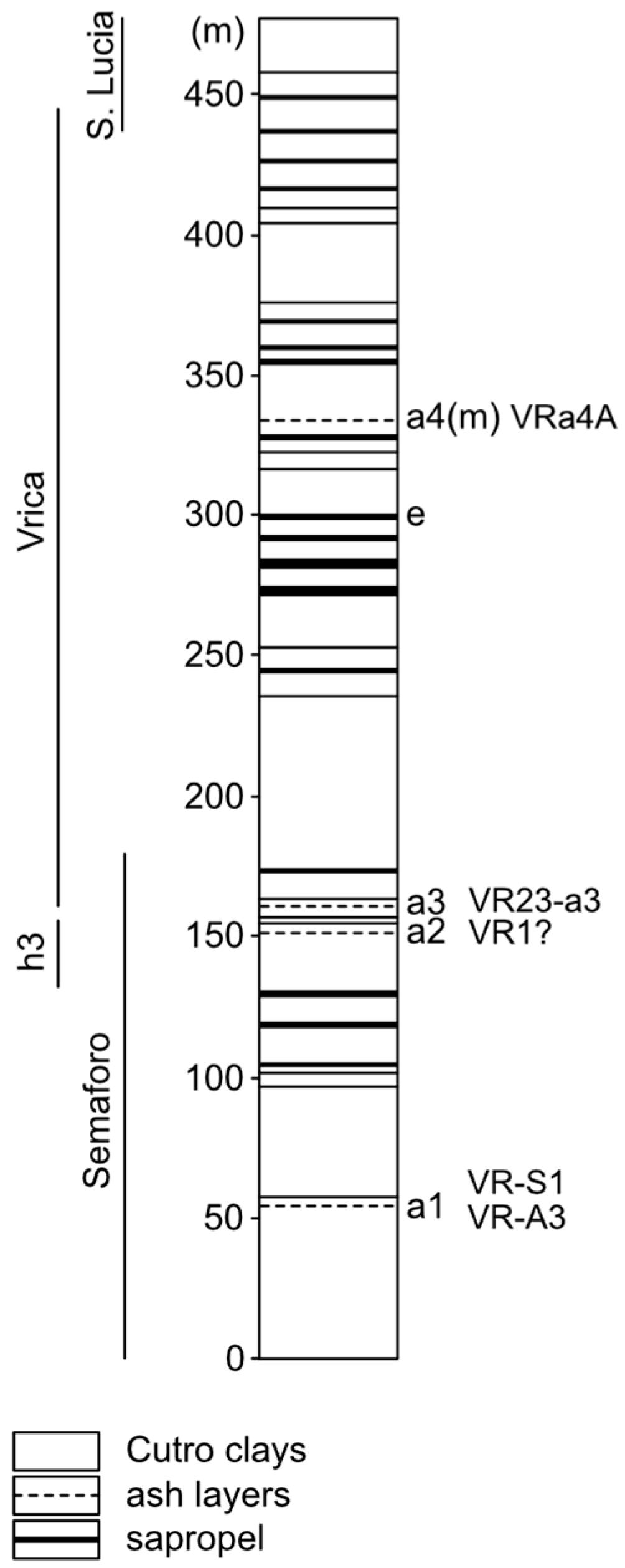
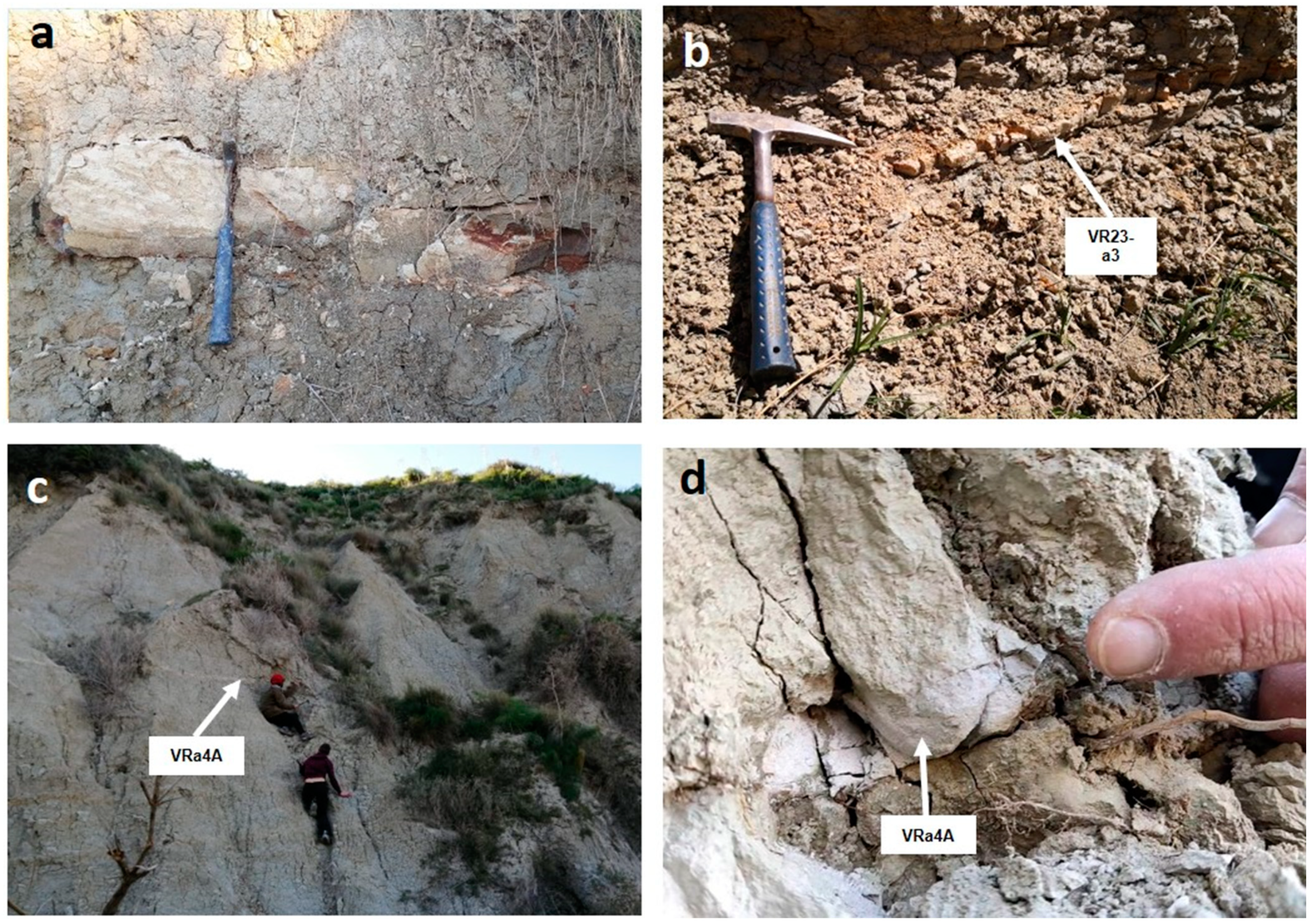
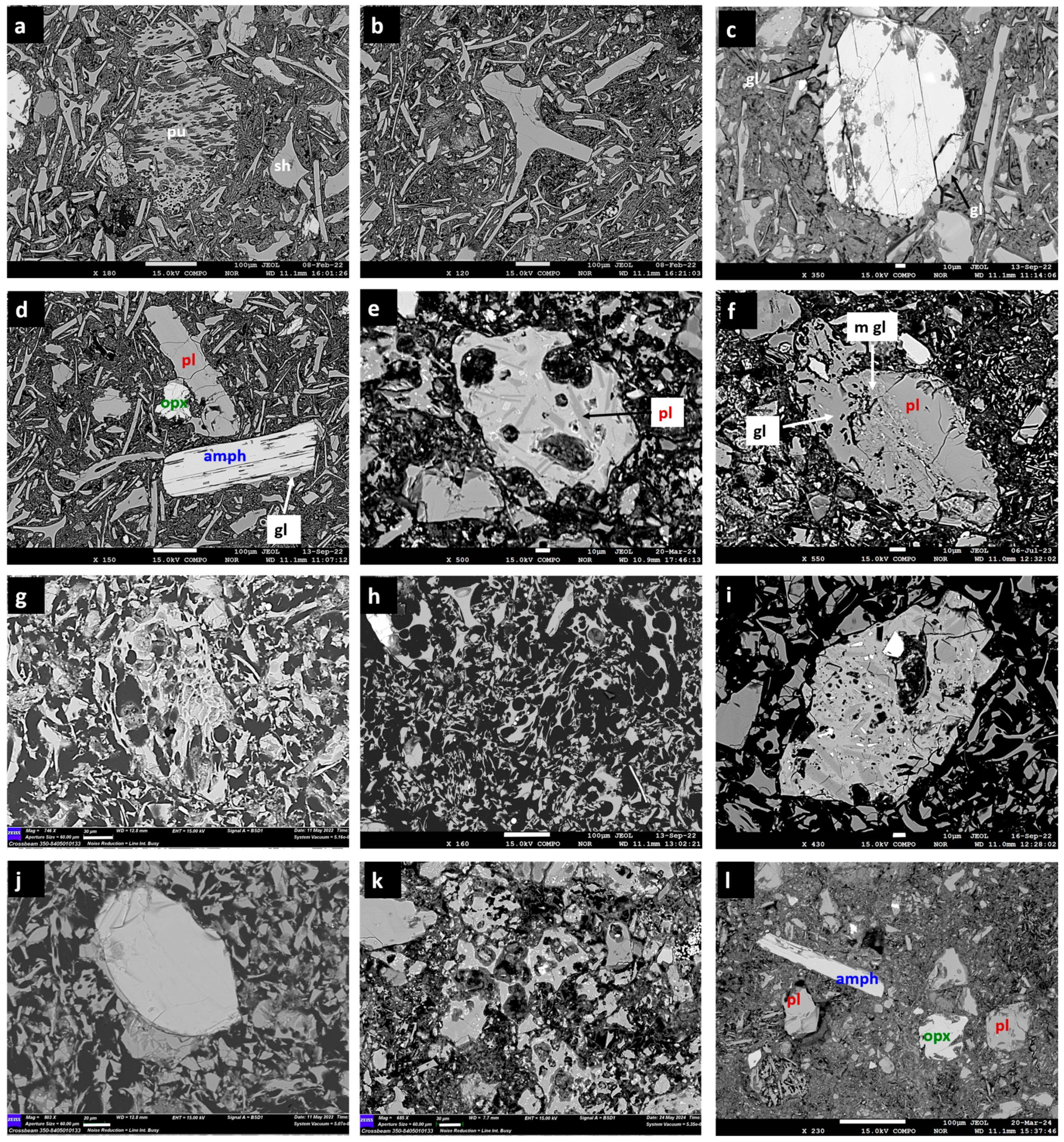


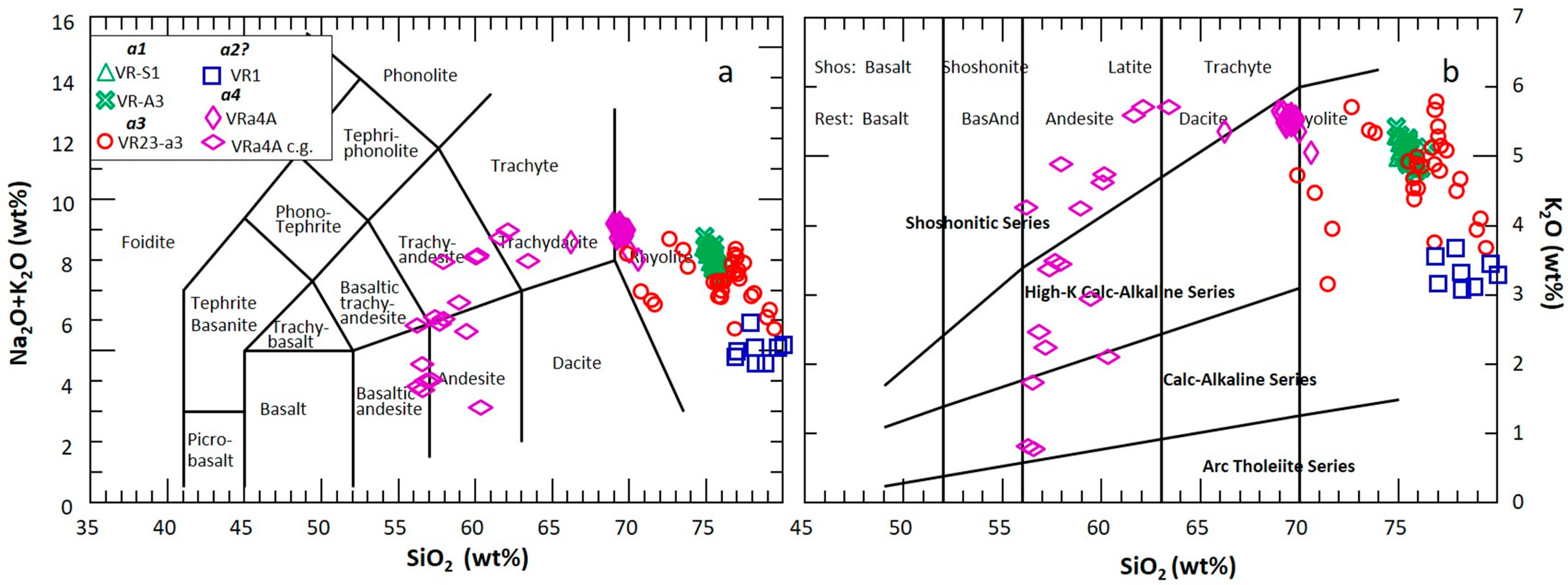


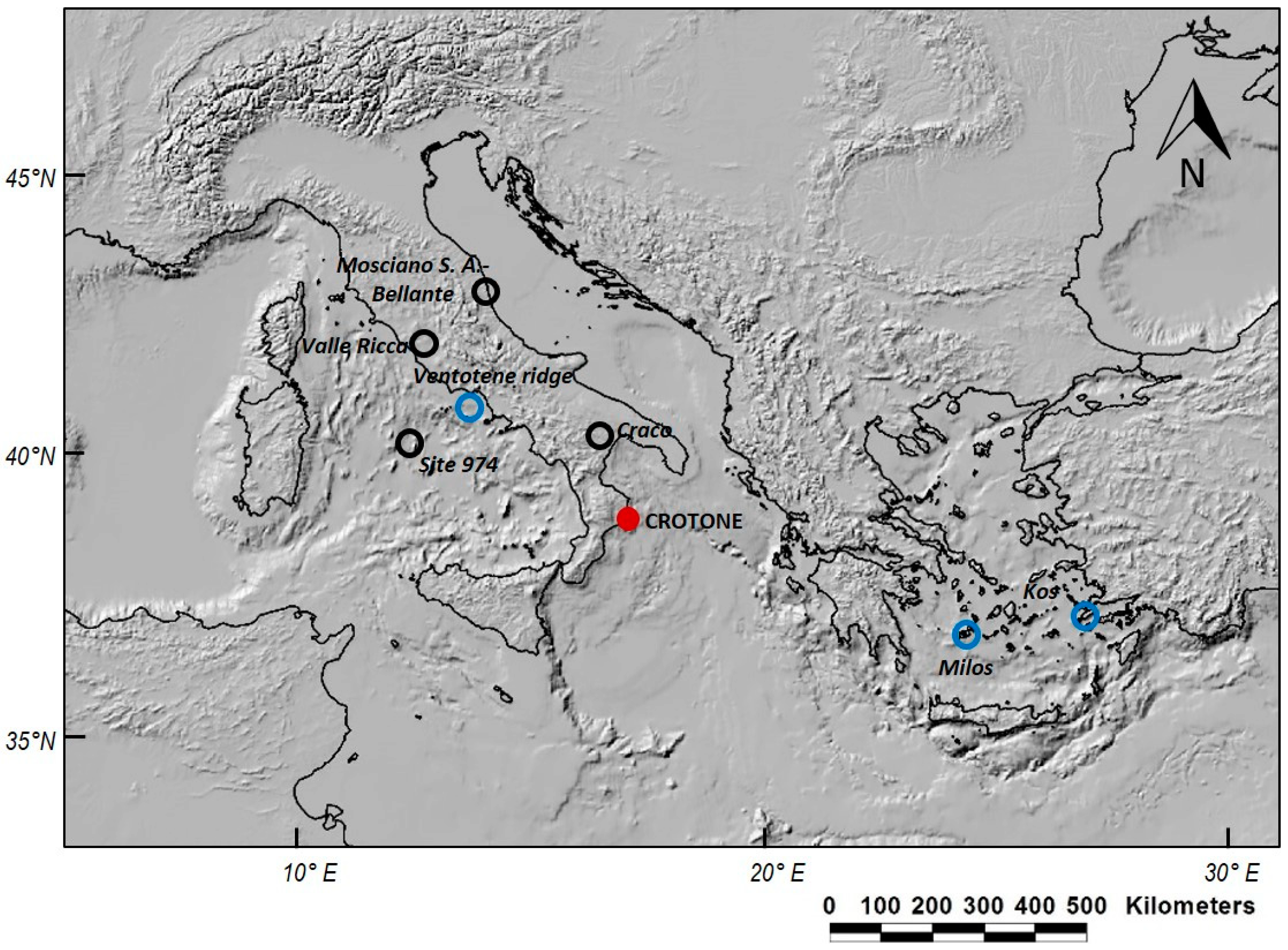
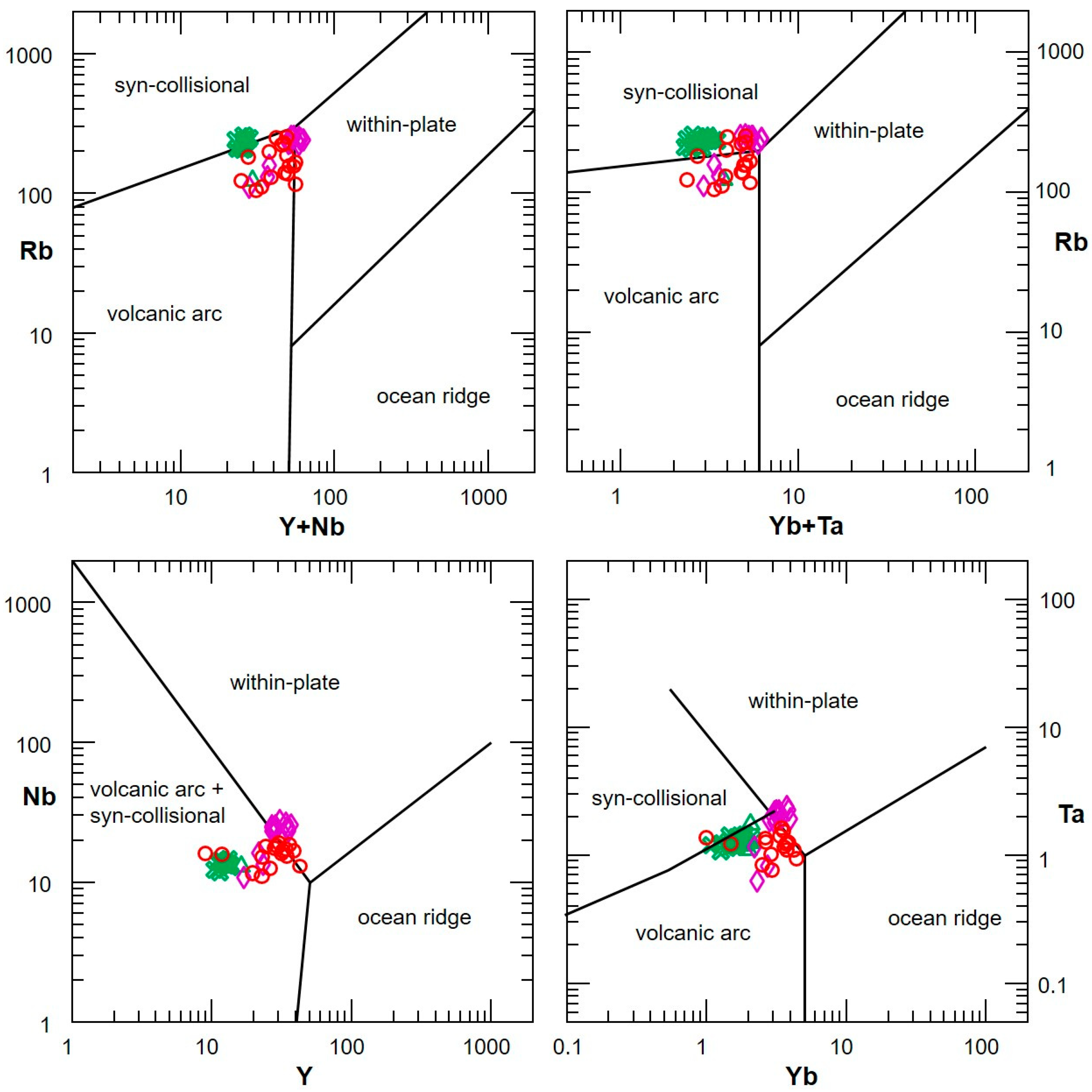
| a1 | a2? | a3 | a4 | |||||||||||
|---|---|---|---|---|---|---|---|---|---|---|---|---|---|---|
| VRS1 * (15) | s.d. | VRA3 (26) | s.d. | VR1 (8) | s.d. | Vr23-a3 pop 1 (23) | s.d. | Vr23-a3 pop 2 (7) | s.d. | VRa4A (27) | s.d. | VRa4A cg (18) | s.d. | |
| SiO2 | 75.28 | 0.24 | 75.53 | 0.31 | 78.31 | 1.13 | 76.99 | 1.12 | 71.99 | 1.44 | 69.40 | 0.72 | 58.67 | 2.18 |
| TiO2 | 0.25 | 0.10 | 0.23 | 0.07 | 0.53 | 0.07 | 0.51 | 0.11 | 0.57 | 0.16 | 0.44 | 0.10 | 1.27 | 0.15 |
| Al2O3 | 13.14 | 0.12 | 13.18 | 0.11 | 13.23 | 0.29 | 12.82 | 0.45 | 14.7 | 0.82 | 16.02 | 0.75 | 15.17 | 1.11 |
| FeO | 1.55 | 0.08 | 1.46 | 0.10 | 1.84 | 0.62 | 1.71 | 0.48 | 2.89 | 0.88 | 2.77 | 0.13 | 9.37 | 1.59 |
| MnO | 0.06 | 0.03 | 0.04 | 0.03 | 0.04 | 0.03 | 0.05 | 0.04 | 0.06 | 0.04 | 0.10 | 0.04 | 0.18 | 0.04 |
| MgO | 0.25 | 0.02 | 0.25 | 0.03 | 0.12 | 0.08 | 0.12 | 0.14 | 0.44 | 0.24 | 0.55 | 0.03 | 3.19 | 1.05 |
| CaO | 0.94 | 0.05 | 0.93 | 0.07 | 0.53 | 0.25 | 0.37 | 0.21 | 1.39 | 0.67 | 1.54 | 0.07 | 5.76 | 1.58 |
| Na2O | 3.05 | 0.22 | 2.91 | 0.21 | 1.71 | 0.31 | 2.4 | 0.27 | 2.91 | 0.45 | 3.39 | 0.18 | 2.57 | 0.69 |
| K2O | 5.08 | 0.11 | 5.07 | 0.16 | 3.34 | 0.22 | 4.76 | 0.55 | 4.67 | 0.9 | 5.51 | 0.12 | 3.51 | 1.58 |
| P2O5 | 0.03 | 0.03 | 0.03 | 0.03 | 0.08 | 0.03 | 0.06 | 0.03 | 0.11 | 0.07 | 0.08 | 0.03 | 0.16 | 0.03 |
| S2O3 | 0.00 | 0.00 | 0.00 | 0.00 | 0.02 | 0.02 | 0.02 | 0.02 | 0.01 | 0.02 | 0.00 | 0.00 | 0.00 | 0.00 |
| Cl | 0.37 | 0.04 | 0.36 | 0.04 | 0.26 | 0.07 | 0.21 | 0.05 | 0.25 | 0.07 | 0.22 | 0.03 | 0.14 | 0.04 |
| sum | 100 | 0 | 100 | 0 | 100 | 0 | 100 | 0 | 100 | 0 | 100 | 0 | 100 | 0 |
Disclaimer/Publisher’s Note: The statements, opinions and data contained in all publications are solely those of the individual author(s) and contributor(s) and not of MDPI and/or the editor(s). MDPI and/or the editor(s) disclaim responsibility for any injury to people or property resulting from any ideas, methods, instructions or products referred to in the content. |
© 2025 by the authors. Licensee MDPI, Basel, Switzerland. This article is an open access article distributed under the terms and conditions of the Creative Commons Attribution (CC BY) license (https://creativecommons.org/licenses/by/4.0/).
Share and Cite
Donato, P.; Cannata, C.B.; Cosentino, A.G.; Davoli, M.; De Rosa, R.; Forni, F. The Lower Pleistocene Tephra Layers in the Crotone Marine Sequence of Southern Italy: Tracing Their Volcanic Source Area. Minerals 2025, 15, 156. https://doi.org/10.3390/min15020156
Donato P, Cannata CB, Cosentino AG, Davoli M, De Rosa R, Forni F. The Lower Pleistocene Tephra Layers in the Crotone Marine Sequence of Southern Italy: Tracing Their Volcanic Source Area. Minerals. 2025; 15(2):156. https://doi.org/10.3390/min15020156
Chicago/Turabian StyleDonato, Paola, Chiara Benedetta Cannata, Antonio Giulio Cosentino, Mariano Davoli, Rosanna De Rosa, and Francesca Forni. 2025. "The Lower Pleistocene Tephra Layers in the Crotone Marine Sequence of Southern Italy: Tracing Their Volcanic Source Area" Minerals 15, no. 2: 156. https://doi.org/10.3390/min15020156
APA StyleDonato, P., Cannata, C. B., Cosentino, A. G., Davoli, M., De Rosa, R., & Forni, F. (2025). The Lower Pleistocene Tephra Layers in the Crotone Marine Sequence of Southern Italy: Tracing Their Volcanic Source Area. Minerals, 15(2), 156. https://doi.org/10.3390/min15020156







